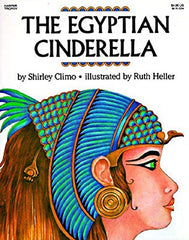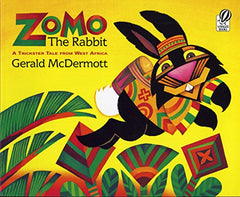Imagine visiting your grandparents as a young child, and after having your dinner/supper, they sit you down to give you stories of why things are the way they are. The stories can range from explaining why certain animals have specific habits, seasonal changes, to creation, and so much more!
This is how African folktales were passed down for many centuries by word of mouth. It wasn't until the 1800s that we saw African folktales written in books.
We wanted to highlight some captivating and fun African folktales for your little ones to read. Feel free to check out our other African-themed children books lists on culture and history, heroes, African countries, and Kenyan storybooks.
 |
A Story, a StoryA Story, a Story: Long, long ago there were no stories on earth for children to hear. All stories belonged to Nyame, the Sky God. Ananse, the Spider man, wanted to buy some of these stories, so he spun a web up to the sky to bargain with the Sky God. The price the Sky God asked was Osebo, the leopard-of-the-terrible-teeth, Mmboro the hornet-who-stings-like-fire, and Mmoatia the fairy-whom-men-never-see. Can Ananse capture these sly creatures and give the children of earth stories to tell? |
 |
AbiyoyoAbiyoyo is an adaptation of a South African lullaby and folk story. In a small town, one young boy loves walking around playing the ukulele, but the people get tired of the clink, clunk, clonk and beg him to stop while covering their ears! The boy’s father has a magic wand he uses to make things disappear, like a playing card or a glass of water—or a chair just as someone’s about to sit.
|
 |
Abiyoyo ReturnsAbiyoyo Returns picks up after Abiyoyo the giant left, the small town he had bothered grew by leaps and bounds. The boy who helped his father make Abiyoyo disappear grew older and became a father, too. The people were filled with new life and spirit. But now there are new dangers: droughts and floods. The town needs a dam before it gets washed away. And sitting right where the dam would be is a boulder too big for anyone to move. Anyone, that is, except Abiyoyo. Father still has his courage. Grandfather still has his magic wand. And his granddaughter knows he can bring Abiyoyo back, then make him disappear. But Abiyoyo is dangerous. People think the giant will eat them. Will lots of good food and beautiful songs keep Abiyoyo happy long enough to move the boulder and once again leave the town in peace? Recommended Age: 4 - 8 years |
 |
Anansi the Spider: A Tale from the AshantiAnansi the Spider: A Tale from the Ashanti is one of the great folk heroes of the world. He is a rogue, a mischief maker, and a wise, lovable creature who triumphs over larger foes. |
 |
Bringing the Rain to Kapiti PlainBringing the Rain to Kapiti Plain is a cumulative rhyme relating how Ki-pat brought rain to the drought-stricken Kapiti Plain. Verna Aardema has brought the original story closer to the English nursery rhyme by putting in a cumulative refrain and giving the tale the rhythm of “The House That Jack Built". Recommended Age: 5 - 8 years |
 |
Favorite African FolktalesFavorite African Folktales gathers in one volume many of Africa's most cherished folktales. Mandela, a Nobel Laureate for Peace, has selected these thirty-two tales with the specific hope that Africa's oldest stories, as well as a few new ones, be perpetuated by future generations and be appreciated by children throughout the world. In these "beloved stories, morsels rich with the gritty essence of Africa," we meet, among many others, a Kenyan lion named Simba, a snake with seven heads and a trickster from Zulu folklore; we hear the voices of the scheming hyena and learn from a Khoi fable how animals acquired their tails and horns. Several creation myths tell us how the land, its animals, and its people all came into existence under a punishing sun or against the backdrop of a spectacularly beautiful mountain landscape. Whether warning children about the dangers of disobedience or demonstrating that the underdog can--and often does--win, these stories, through their depiction of wise animals as well as evil monsters, are "universal in their portrayal of humanity, beasts, and the mystical. Recommended Age: All Ages |
 |
Head, Body, Legs: A Story from LiberiaHead, Body, Legs: A Story from Liberia is a magical retelling of a Liberian creation story Head is all alone. Body bounces along. Arms swing about. Legs stand around. They can't do much by themselves, so they try to work together. But how? This vibrant, joyous retelling of a traditional Liberian creation story shows how much can be accomplished with a little cooperation. Recommended Age: 4 - 8 years |
 |
How the Amazon Queen Fought the Prince of EgyptHow the Amazon Queen Fought the Prince of Egypt: Queen Serpot rules the Land of Women, where the Amazon women live free, without men, and hunt and fight their own battles. But one day their peace is broken. An army of Egyptian soldiers is approaching their land, led by their prince, Pedikhons. Pedikhons has heard stories of these warrior women. Now he has come to see them with his own eyes -- and to challenge them to combat. But the brave Serpot and her women are full of surprises. Can woman truly equal man in strength and courage? Recommended Age: 7 - 11 years |
 |
How the Guinea Fowl Got Her Spots: A Swahili Tale of FriendshipHow the Guinea Fowl Got Her Spots: A Swahili Tale of Friendship: The Guinea Fowl and Cow are best friends. Both of them keep an eye out for Lion. When Lion threatens, each must intervene to save the other. Beautiful watercolors transform this tale into a visual delight. |
 |
Mrs. Chicken and the Hungry CrocodileMrs. Chicken and the Hungry Crocodile: A Swahili Tale of Friendship: Mrs. Chicken has to think fast to outwit hungry Crocodile, who wants to eat her for dinner. One morning Mrs. Chicken took her bath in a puddle. Mrs. Chicken can't see her wings in the puddle, so she walks down to the river where she can admire all of herself. She doesn't know that Crocodile is there, waiting for dinner―and a tasty chicken would do nicely! To save herself, Mrs. Chicken tells Crocodile that they are sisters.
|
 |
Sense Pass KingSense Pass King: When the king discovers that a girl named Sense Pass King possesses such extraordinary gifts and intelligence that even surpass him, he is enraged and a battle of wits and wisdom commences, determining Sense Pass King's fate and the future of the kingdom. |
 |
The Egyptian CinderellaThe Egyptian Cinderella: This Egyptian spin on the classic Cinderella tale was initially recorded in the first century by a Roman historian and is retold here by folklorist Shirley Climo. Poor Rhodopis! She has nothing—no mother or father, and no friends. She is a slave, from the far-off country of Greece. Only the beautiful rose-red slippers her master gives her can make Rhodopis smile. So when a falcon swoops down and snatches one of the slippers away, Rhodopis is heartbroken. For how is she to know that the slipper will land in the lap of the great Pharaoh himself? And who would ever guess that the Pharaoh has promised to find the slipper’s owner and make her queen of all Egypt? |
 |
The Hatseller and the Monkeys: A West African FolktaleThe Hatseller and the Monkeys: A West African Folktale: tells an African version of the familiar story of a man who sets off to sell his hats, only to have them stolen by a treeful of mischievous monkeys. Recommended Age: 4 - 8 years |
 |
The Name of the Tree: A Bantu Tale RetoldThe Name of the Tree: A Bantu Tale Retold: When a drought spreads through the land of the short grass, the animals set out across the great plain to find food. Their only hope for survival is a tree with a variety of colorful fruit. The problem is its branches are too high. To reach them, the wise old turtle says, one must know the name of the tree, something only King Lion is privy to. Recommended Age: 3 - 8 years |
 |
When the Sun and Moon Live in the SkyWhen the Sun and Moon Live in the Sky: Sun and his wife, the moon, lived on Earth and built a large house so that the water people could visit. But so many poured in that they were forced to move to the sky. |
 |
Who's in Rabbit's House?Who's in Rabbit's House? is a great bedtime story sure to keep children fascinated, Who’s in Rabbit’s House is a Masai tale told from the perspective of a play within a play. A monster has invaded Rabbit’s house, and the other animals must gather to help investigate . . . and scare the monster away. This story teaches children it is important to help each other in times of need. Recommended Age: 5 - 9 years |
 |
Why Mosquitoes Buzz in People's Ears: A West African TaleWhy Mosquitoes Buzz in People's Ears: In this Caldecott Medal winner, Mosquito tells a story that causes a jungle disaster. Recommended Age: 5 - 9 years |
 |
Why The Sky Is Far Away: A Nigerian FolktaleWhy The Sky Is Far Away: A Nigerian Folktale: The sky was once so close to the Earth that people cut parts of it to eat, but their waste and greed caused the sky to move far away. |
 |
Why the Sun and the Moon Live in the SkyWhy The Sun and the Moon Live in the Sky: A folktale from Nigeria, that tells how it came that the Sun and Moon are in the sky. |
 |
Zomo the Rabbit: A Trickster Tale from West AfricaZomo the Rabbit: A Trickster Tale from West Africa: Zomo the rabbit, a trickster from West Africa, wants wisdom. But he must accomplish three apparently impossible tasks before Sky God will give him what he wants. Is he clever enough to do as Sky God asks? Recommended Age: 4 - 7 years |





